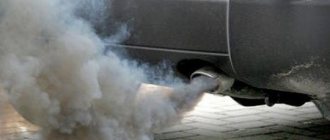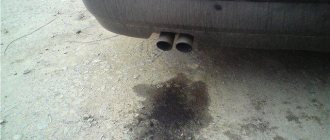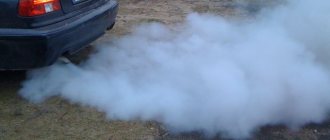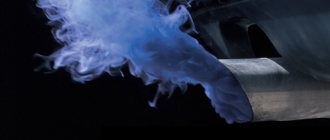Blue or gray smoke from the exhaust pipe indicates combustion of engine oil in the cylinders. Among the reasons for the appearance of bluish smoke are wear of the cylinder-piston group, insufficient cylinder sealing in the area of the piston rings, hardening of the valve stem seals and turbine malfunction. Each breakdown has a number of signs that simplify diagnosis and help identify faults by the color of the exhaust of a gasoline/diesel engine.
Blue smoke: causes of increased oil consumption
Blue smoke from the exhaust pipe is always accompanied by increased oil consumption. The main reasons for high engine lubricant consumption:
- Worn valve stem seal and valve guides. Valve seals prevent oil from entering the valve stem from the cylinder head cavity into the engine combustion chamber;
- large clearance of turbocharger plain bearings. Since proper sealing of the shaft is impossible due to the large gap, the oil is sucked into the intake tract and burns in the cylinders with a fresh charge of the fuel mixture. It is also possible for oil to enter the exhaust tract, where it will burn off the hot parts of the exhaust system, producing smoke with a bluish tint;
- clogged oil return line from the turbocharger. The malfunction occurs when maintenance intervals are not observed or low-quality engine oil is used. Since lubricant is supplied to the turbine under pressure, resistance to draining excess oil back into the sump leads to lubricant entering the intake tract through the plain bearings;
- high pressure of crankcase gases. Excessive pressure in the engine sump creates air pressure, which prevents the piston rings from removing excess oil. As a result, too much lubricant remains on the surface of the cylinders, which burns and causes thick blue smoke from the exhaust pipe;
- leakage of the joint between the cylinder block and the cylinder head. Oil enters the combustion chamber through areas of weakening of the cylinder head gasket to the cylinder block. If the leak is not limited to oil, and antifreeze also gets into the cylinders, blue-white smoke will come out of the exhaust pipe;
- a consequence of engine repair in violation of the technology of processing, boring, honing and liner of the cylinder block. To create an oil film of the correct thickness (1-3 microns), it is important not only to maintain the geometry of the cylinders, but also to maintain the degree of surface roughness;
- malfunction of the cylinder-piston group (CPG).
A unique solution to the problem of light blue haze at startup
with a mileage of 55-60 thousand, I also noticed a slight blue smoke
when starting the engine when cold. I thought and thought, and came up with the following crap (the most interesting thing works perfectly): I’ll write it briefly, I hope it will be clear and simpler. 1. Logically, the valve stem seals sit on the valve stems and work with any movement of the valve and are not always doused with oil in the required volume (therefore, it is better not to put a load on the engine when it has just started). 2. The valves in the internal combustion engine allow an air-gasoline mixture (at the inlet) and an air-gasoline-fire mixture (at the outlet) to pass around them. 3. any motor oil (even the highest quality and from the manufacturer) cokes in some tiny proportion on hot surfaces and creates aggressive environment in its absence in the metal-rubber part of the caps. 4. the rubber on the caps (or a brown/black rim of a different composition that slides along the valve stem) becomes coarser from being in an oil environment for a long time and temperature changes (and is covered with something like glass film (look at the caps, which after removal will lie in the open air for a couple of months 5. The groove in the pistons under the rings is clogged with the same substance as in point 4, let’s call it carbon deposits 6. The oil in engines is usually changed using the method: drained, changed filter - filled with fresh oil 7. Motors usually operate in fairly harsh modes - either up to 2-2.5 thousand revolutions, or 3-4. 8. Hundredths of a gram or microgram with each revolution of the engine flywheel burns and escapes into the atmosphere through the exhaust manifold and catalyst.
These were the theses from which I proceeded in the process of my reflections. The logic then went the following way: here we have oil, which during engine operation cokes in various parts of the engine, including on all sorts of rubber bands and moving parts (including the crankshaft). There is some amount of soot (again, in the stroke mode, this can be ten-thousandths or millionths of a gram) that is deposited on the cylinder walls and gets into the oil. Accordingly, in the engine we will have 3 places where soot will accumulate: this is the oil itself, the oil filter, and the exhaust manifold with exhaust valves as well. I’ll pause a little - in one very smart book I read that everything in our world is attracted to each other with some force and the basis for this is positive-negative charges of electricity, air-steam mixtures, centrifugal forces, etc. yes, I forgot - in theory, as a rule, such forces are simply neglected, since they (the forces of attraction of objects) in almost 100% of cases are so small that, for example, moving 1 thousandth of a gram per 1 thousandth of a millimeter when using these forces will take a lot of time. Accordingly, taking into account all of the above, we can conclude that some particle(s) of soot will “stick” to the valve stem in the oil bath during 1 engine stroke. and if we purely theoretically calculate how many revolutions our valve makes during movement, then purely theoretically
it can be obtained that with a mileage of 60-65 thousand km, some kind of carbon layer forms on the valve stem and on the elastic band that fits it (that is, the oil scraper cap), which makes it difficult to remove the oil when starting the engine until this carbon warms up and will not become more or less elastic. Conclusion and emerging problem: the cause of the smoke is the inelasticity of the valve stem seal. The problem is removing carbon deposits from the surface of the valve stem seal.
Blue smoke appears only when cold
The appearance of blue smoke from the exhaust pipe after the car has been parked for a long time indicates wear of the valve stem seals. With constant temperature changes, rubber products lose their elasticity. At high mileage, wear of the valve sleeve and stem leads to valve runout. Due to the loss of elasticity, the compression force on the rod decreases, so a gap appears between the valve stem and the cap, through which the oil flows into the combustion chamber. During long-term parking, lubricant accumulates in the cylinders, which actively burns out after starting. It is typical that after 3-5 minutes of warming up the engine, the blue smoke may practically disappear.
You can check the valve seals without disassembling the cylinder head using an endoscope with a rotating camera. Looking into the cylinders after a long period of parking, you can see fresh drops of oil flowing onto the piston through the valve rod. On many cars, with the valve cover removed, you can visually assess the fit of the caps and the integrity of the compression spring. You can check the elasticity of the rubber only after dismantling the seals. If you have never dealt with engine repairs and do not have experience checking the caps, the best diagnosis is to compare the elasticity of the old and new oil seals (just try to compress them one by one).
Reasons for failure of oil scraper rings
There are several reasons, I will list them point by point:
1) Poor quality oil. The whole point is that if you use low-quality materials to lubricate the engine or those that are not prescribed by the manufacturer. This can cause increased wear of parts, especially rings. They will quickly wear off and begin to leak oil.
2) Untimely oil change. It’s similar to the first point, but here the oil loses its properties due to high mileage, which can also cause a lot of wear.
3) Engine overheating. If you overheat the engine, the temperature rises above a critical level, then engine parts may become deformed from high temperatures. Oil rings are no exception to this.
4) Incorrect assembly during repair. Incorrectly installed rings during engine overhaul may also be the cause.
5) If the car has not been used for a long time, then it may simply rust and “pockets” of corrosion may appear on the rings, through which oil will also pass.
CPG condition
When the valve seals have been replaced, the turbine and crankcase ventilation system have been checked, and the blue smoke from the exhaust system has not disappeared, pay attention to the condition of the cylinder-piston group. Most likely, there is too much clearance between the piston and cylinder. This happens either due to the fact that the piston rings are stuck/worn out and do not perform their functions, or due to wear at the point of contact of the piston skirt with the cylinder. Both types of malfunction are only consequences caused by high mileage, unqualified repairs or non-compliance with service intervals.
In a 4-stroke internal combustion engine, piston rings perform the following functions:
- seal against exhaust gases breaking into the crankcase. On modern cars, a high degree of sealing is achieved by using two compression rings;
- removal and distribution of oil. The rings should not only distribute the lubricant evenly throughout the cylinder, but also regulate the thickness of the oil film;
The main volume of excess lubricant is removed by the oil scraper ring (3rd in a row), as well as by the second combined compression ring.
- heat removal from the piston. About 70% of the heat absorbed by the piston is removed through the piston rings (55% of the total volume falls on the 1st compression ring, 30% on the 2nd compression ring and 15% on the oil scraper ring).
Repair
Repairs here cost a lot of money. As a rule, such breakdowns “come out” on very worn engines - and then you just have to “dig” and away you go. BUT, in essence, you need to change the rings, and also grind the surface of the cylinder (as motorists say, “to fill a mirror”), this does not always work out, and therefore sometimes the engine block itself is bored for pistons and rings of larger diameter. Watch a short but useful video about replacing rings.
Previously, 20 - 30 years ago, boring was a completely normal process, the oils were terrible then, and there was only one coolant - water. Therefore, the engines did not run for very long, and they were repaired. Now, in the era of synthetic oils and coolants, such types of work are forgotten; boring a block is now a very rare activity.
As you can see, repairs are quite complex and expensive, so it is better to properly care for your car. Use good oil, change it on time, and also monitor the coolant to avoid overheating. Then you can forget about blue smoke!
I’ll finish this, read our AUTOBLOG.
Similar news
- Speed sensor repair. Using the 2008 Chevrolet AVEO as an example
- Is it worth repairing the steering rack? What's the benefit?
- Do I need to change springs when replacing shock absorbers (struts). Sort it out...
Add a comment Cancel reply
Why don't piston rings work?
Reasons for ring failure:
- loss of elasticity and resilience due to overheating or a large number of heating/cooling cycles (natural metal fatigue, which occurs over long runs);
- coked piston rings. The rings stick if varnish deposits and carbon deposits form inside the piston grooves. If the compression rings stick in the cylinders, compression decreases, the thermal load on the oil scraper ring increases, and the crankcase gas pressure increases. At high mileage, the car emits blue smoke due to coking of the oil scraper rings. In some cases, a malfunction occurs after the car has been left idle for a long time, low-quality engine oil has been used, and maintenance intervals have been ignored;
- insufficient thermal gap. As thermal expansion occurs, the rings put excessive pressure on the cylinder, causing them to overheat, wear out faster, and create scuffing on the cylinder walls;
- piston movement is skewed. Misalignment as a result of bending of the connecting rod leads to a rocking movement of the piston in the longitudinal axis of the engine, which is why scuff marks appear on the cylinder walls and piston skirts, and the piston rings take on an elliptical shape;
- violation of the geometric shape of the cylinder. Occurs due to coked piston rings, skewed piston movement or unskilled repairs (poor-quality boring/liner of the cylinder block, non-compliance with the sequence and tightening torque of the cylinder head bolts);
- errors in troubleshooting engine parts during major repairs. For example, installing new pistons and rings into cylinders with worn tops causes the rings to hit the shoulder, vibrate, wear out quickly, and no longer seal properly. Similar symptoms occur when the pistons barely noticeably hit the cylinder head, which is caused by an incorrect protrusion of the pistons or a small thickness of the cylinder head gasket. New piston rings cannot be installed if the cylinder has an elliptical bore;
- Incorrectly installed or selected piston rings. Excessive tension with unqualified installation will soon result in bluish smoke during gas changes and increased oil consumption.
The nature of smoke and the degree of wear of the power unit
Experienced specialists, based on their own observations or the client’s descriptions of the characteristics of smoke, can with a high degree of probability guess the nature of the problem. Let's look at a few common cases :
- If the blue-white exhaust appears only when the engine warms up and gradually disappears as it warms up, then there is no reason to fear serious wear of the mechanisms. This effect is explained by the ability of parts to expand; when heated, the gaps decrease and oil leakage stops.
- In the case when, after warming up the power unit, smoking not only continues, but also intensifies, it can be argued that there is significant wear of the internal combustion engine elements. The reason is the following - the expansion is not enough to reliably seal the gaps and through them hot oil easily penetrates into the cylinders.
It goes without saying that blue or blue-white smoke from the muffler is accompanied by increased oil consumption. Therefore, monitoring its level using a dipstick is a necessary operation, which makes it possible to determine a breakdown in the early stages of its occurrence. Exceeding the consumption rate of lubricants should immediately alert the owner. In addition, on modern cars, due to the fact that they are equipped with a neutralizer that can purify gases, it is not always possible to determine the color of the exhaust even with increased oil consumption.
We must not forget about such a phenomenon as compression, the degree of which can sometimes be misleading. So, at first glance, wear of the CPG elements is quite often characterized by loss of compression and increased crankcase gas pressure. However, at the same time, a significant amount of oil seals the gaps and if they are not very far from standard, then the compression gauge readings may be normal, and sometimes closer to the upper limit.
How does detonation and poor mixture composition ruin your engine?
Detonation combustion not only leads to shock loads on the partitions, piston crown, and valves, but also tears off the oil film from the cylinder walls and provokes rattling of the piston rings. The consequences of glow ignition are similar, in which the fuel mixture is ignited not by a spark, but by contact with a hot spark plug.
Detonation is the explosive combustion of a mixture with high peak pressure in the combustion chamber.
Overflowing fuel injectors also lead to the breakdown of the oil film. Scouring on the cylinder walls is a natural consequence of dry friction of the piston against the cylinder.
Eventually
Operating a car with blue exhaust is not only uncomfortable for those around you and passengers, but is also extremely detrimental to the components of the car. Therefore, at the first sign of an atypical exhaust, you should analyze the situation yourself or contact a specialist.
The reason should be sought in components that are actively in contact with oil, and this is, first of all, the cylinder-piston group, automatic transmission with a vacuum load sensor, and also the turbocharger.
Causes of transmission oil leaks and ways to eliminate them
What is engine detonation and what are the causes of its occurrence?
Malfunction of the crankcase ventilation system
Symptoms of a faulty VCG system:
- The engine emits blue smoke.
- Oil fogging is observed near the valve cover, oil pan, timing chain cover, oil filler neck, crankshaft and camshaft seals.
- Increased oil consumption.
- Oil deposits in the intake tract.
Due to the backpressure of exhaust gases after draining the oil from the turbocharger, a large amount of oil can accumulate in the “cold” part pipe and the intercooler. In this case, it is easy to make the mistake of sending the turbine for repair or replacing it with a new one. The root cause of oil deposits and blue exhaust may be low VCG flow capacity or a faulty PCV valve.










